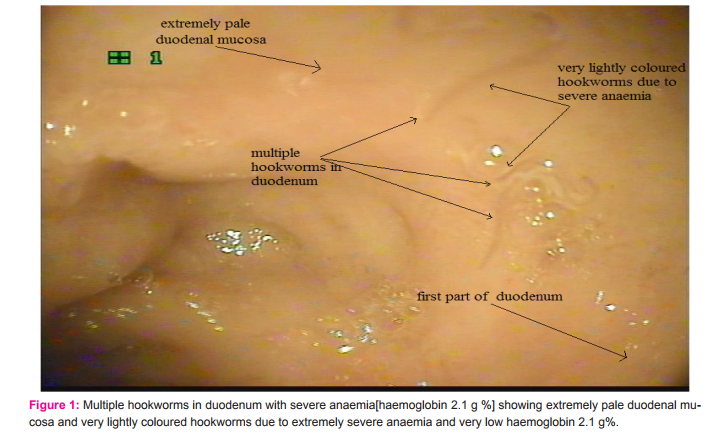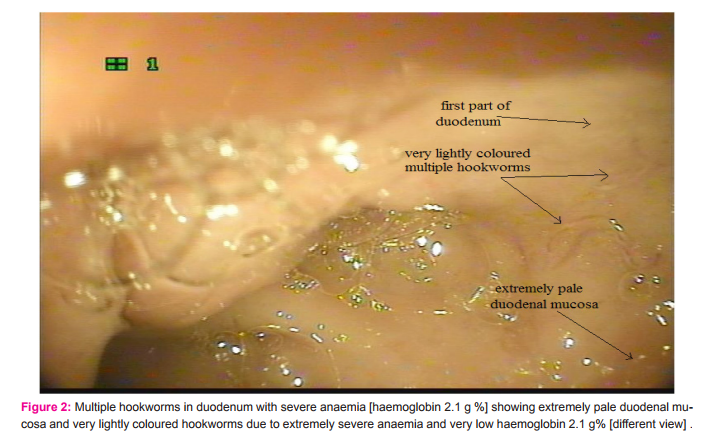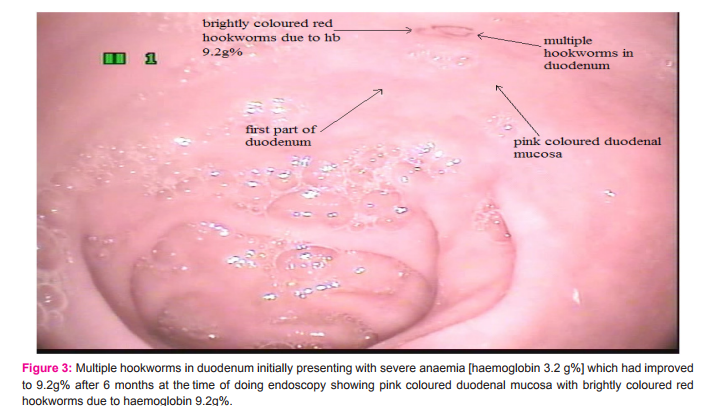IJCRR - 7(19), October, 2015
Pages: 01-05
Date of Publication: 10-Oct-2015
Print Article
Download XML Download PDF
A DETAILED STUDY OF SEVERE ANAEMIA AND ITS RELATION WITH STOOL EXAMINATION FOR HOOKWORM OVA IN PATIENTS WITH SEVERE HOOKWORM INFECTION FOUND WHILE DOING
ENDOSCOPY
Author: Govindarajalu Ganesan
Category: Healthcare
Abstract:Objective: Severe anaemia is reported to occur in severe hookworm infection in many studies. But so far detailed study was not done to know about the occurence of severe anaemia and its relation with stool examination for hookworm ova in patients with severe hookworm infection. Hence a detailed study was done to know about severe anaemia and its relation with stool examination for hookworm ova in patients with severe hookworm infection found while doing upper gastro intestinal endoscopy in our institute. Methods: A study of 1100 patients who had undergone upper gastro-intestinal endoscopy for a period of four and half years from May 2009 to October 2013 was carried out in our institute. In each of these 1100 patients, the first and second part of duodenum were carefully examined to find out the presence of hookworms. In all the patients found to have hookworms in duodenum, investigations were done to know about the presence of anaemia except in the very few patients who were lost for follow up. In patients with severe anaemia [haemoglobin < 7g/dl or g%] stool examination was done to look for the presence or absence of hookworm ova. The results were found as given below. Results: Out of these 1100 patients, as many as 18 patients were found to have hookworms in duodenum while doing upper gastro-intestinal endoscopy. Out of these 18 patients, 4 patients were lost for follow up and full details about their investigations were not available. The remaining 14 patients were taken into consideration for our study. Out of these14 patients, 9 patients had anaemia and 2 of these 9 patients were found to have severe anaemia [haemoglobin < 7g/dl or g%]. Severe anaemia indicates significant loss of blood which will occur only due to heavy burden of hookworms in severe hookworm infection. Hence severe anaemia is suggestive of severe hookworm infection due to heavy burden of hookworms. But in both these patients, stool examination was negative for hookworm ova despite a heavy burden of hookworm infection with severe anaemia.
Conclusion: Thus even a heavy burden of hookworm infection with severe anaemia can present with negative stool examination for hookworm ova. Hence upper gastro intestinal endoscopy should be done to confirm the presence of hookworms in all patients with anaemia even when stool examination is negative for hookworm ova.
Keywords: Severe anaemia, Severe hookworm infection, Stool examination for hookworm ova, Upper gastro intestinal endoscopy
Full Text:
INTRODUCTION
Severe anaemia is reported to occur in severe hookworm infection in many studies[1 to 16]. But so far detailed study was not done to know about the occurence of severe anaemia and its relation with stool examination for hookworm ova in patients with severe hookworm infection. Hence a detailed study was done to know about severe anaemia and its relation with stool examination for hookworm ova in patients with severe hookworm infection found while doing upper gastro intestinal endoscopy in our institute.
MATERIALS AND METHODS
This study was conducted in the department of general surgery, Aarupadai Veedu Medical College and Hospital, Puducherry. A study of 1100 patients who had undergone upper gastro-intestinal endoscopy for a period of four and half years from May 2009 to October 2013 was carried out in our institute. In each of these 1100 patients, the first and second part of duodenum were carefully examined to find out the presence of single or multiple hookworms. In all the patients found to have hookworms in duodenum, investigations were done to know about the presence of anaemia except in the very few patients who were lost for follow up. In patients with severe anaemia [haemoglobin <7g/dl or g%] stool examination was done to look for the presence or absence of hookworm ova. Anaemia is defined as haemoglobin < 12g/ dl or 12g% in women and haemoglobin or < 13g/dl or13g% in men. Mild anaemia is taken as haemoglobin 10to12g/dl or g%, moderate anaemia is taken as haemoglobin 7to10g/dl or g% and severe anaemia is taken as haemoglobin <7g/dl or g% . The results were found as given below.
RESULTS
Out of these 1100 patients, as many as 18 patients were found to have hookworms in duodenum while doing upper gastro-intestinal endoscopy. Out of these 18 patients, 4 patients were lost for follow up and full details about their investigations were not available. The remaining 14 patients were taken into consideration for our study. Out of these14 patients, 9 patients had anaemia and 2 of these 9 patients were found to have severe anaemia [haemoglobin <7g/dl or g%]. Severe anaemia indicates significant loss of blood which will occur only due to heavy burden of hookworms in severe hookworm infection.
1. Severe anaemia and its relation with stool examination for hookworm ova.
a. In both the patients with severe anaemia in our study [ haemoglobin 2.1 g%,3.2g%], stool examination was negative for hookworm ova despite heavy burden of hookworm infection with severe anaemia.
b. Many studies have also shown negative stool examination for hookworm ova despite heavy burden of hookworm infection with severe anaemia[1, 2, 9 to 16].
2. Severe anaemia and age of the patient.
a. Both the patients with severe anaemia in our study were old patients with more than 45 years of age .
b. One patient was 47 years old and the other patient was 60 years old.
DISCUSSION
1. Upper gastro intestinal endoscopy as an indicator of severe anaemia due to the appearance of extremely pale mucosa.
a. The patient with severe anaemia due to severe hookworm infection with multiple hookworms shown in fig 1, 2 had extremely pale duodenal mucosa and very lightly coloured hookworms due to extremely severe anaemia and very low haemoglobin 2.1 g%.
b. Extremely low haemoglobin 2.1 g% occurs only very rarely and has occured in our patient.
c. Due to extremely low haemoglobin, the duodenal mucosa has become extremely pale and hence only very lightly coloured hookworms are seen in fig1, 2.
d. Hence extremely pale duodenal mucosa with very lightly coloured hookworms seen while doing upper gastro intestinal endoscopy is also a very important indicator of extremely severe anaemia in this patient.
e. Thus upper gastro intestinal endoscopy can also indicate the presence of severe anaemia due to the appearance of extremely pale mucosa of the upper gastro intestinal tract.
2. Negative stool examination for hookworm ova.
a. In the patient with haemoglobin 2.1g%, upper gastro intestinal endoscopy was immediately done and fortunately the diagnosis of hookworm infection was immediately made despite negative stool examination for hookworm ova.
b. But in the patient with haemoglobin 3.2g%, upper gastro intestinal endoscopy was done only after 6 months of the initial presentation since repeated stool examination done in these 6 months was persistently negative for hookworm ova in this patient.
c. Since upper gastro intestinal endoscopy was done only after 6 months of the initial presentation, haemoglobin of the patient had improved to 9.2g% and hence the duodenal mucosa was pink in colour with brightly coloured red hookworms which is shown in fig3.
3. Importance of upper gastro intestinal endoscopy in the early diagnosis of hookworm infection.
a. In both our patients, stool examination was negative for hookworm ova despite a very heavy burden of hookworm infection with severe anaemia.
b. In other studies also, stool examination was negative for hookworm ova despite a very heavy burden of hookworm infection with severe anaemia[1, 2, 9 to 16].
c. In both our patients, hookworm infection could be diagnosed in our institute despite negative stool examination for hookworm ova only by doing upper gastro intestinal endoscopy.
d. Hence upper gastro intestinal endoscopy is an extremely useful investigation and is very helpful in the early diagnosis of hookworm infection even when stool examination is negative for hookworm ova.
CONCLUSION
1. In both our patients with severe anaemia due to severe hookworm infection with multiple hookworms in duodenum seen while doing upper gastro intestinal endoscopy, stool examination was negative for hookworm ova.
2. Thus even a very heavy burden of hookworm infection with severe anaemia with multiple hookworms in duodenum seen during endoscopy can present with negative stool examination for hookworm ova.
3. Hence upper gastro intestinal endoscopy should be done to confirm the presence of hookworms in all patients with anaemia in tropical countries even when stool examination is negative for hookworm ova.
ACKNOWLEDGEMENT
The author sincerely thanks the staff nurse Nithya who was assisting the author while doing endoscopy and the staff nurses A.K. Selvi and Nithya for their immense help rendered to the author while conducting this work. The author acknowledges the immense help received from the scholars whose articles are cited and included in references of this manuscript. The author is also grateful to authors / editors / publishers of all those articles, journals and books from where the literature for this article has been reviewed and discussed. The author is extremely grateful to IJCRR editorial board members and IJCRR team of reviewers who have helped to bring quality to this manuscript.


 \
\
References:
1. Hyun HJ, Kim EM, Park SY, Jung JO, Chai JY, Hong ST . A case of severe anemia by Necator americanus infection in Korea. J Korean Med Sci. 2010 Dec;25(12):1802-4.
2. Wu KL, Chuah SK, Hsu CC, Chiu KW, Chiu YC, Changchien CS. Endoscopic Diagnosis of Hookworm Disease of the Duodenum: A Case Report. J Intern Med Taiwan 2002;13:27-30.
3. Kuo YC, Chang CW, Chen CJ, Wang TE, Chang WH, Shih SC . Endoscopic Diagnosis of Hookworm Infection That Caused Anemia in an Elderly Person. International Journal of Gerontology. 2010 ; 4(4) : 199-201
4. Nakagawa Y, Nagai T, Okawara H, Nakashima H, Tasaki T, Soma W, et al. Comparison of magnified endoscopic images of Ancylostoma duodenale (hookworm) and Anisakis simplex.Endoscopy 2009;41(Suppl. 2):E189
5. Basset D, Rullier P, Segalas F, Sasso M. Hookworm discovered in a patient presenting with severe iron-deficiency anemiaMed Trop (Mars). 2010 Apr;70(2):203-4
6. Lee T.-H., Yang J.C., Lin J.T., Lu S.C. and Wang T.H. Hookworm Infection Diagnosed by Upper Gastrointestinal Endoscopy: —Report of Two Cases with Review of the Literature—. Digestive Endoscopy, 1994 6(1): 66–72
7. Anjum Saeed, Huma Arshad Cheema, Arshad Alvi, Hassan Suleman. Hookworm infestation in children presenting with malena - Case series Pak J Med Res Oct - Dec 2008;47(4) ):98- 100
8. A Rodríguez, E Pozo, R Fernández, J Amo, T Nozal. Hookworm disease as a cause of iron deficiency anemia in the prison population Rev Esp Sanid Penit 2013; 15: 63-65
9. Li ZS1, Liao Z, Ye P, Wu RP Dancing hookworm in the small bowel detected by capsule endoscopy: a synthesized video. Endoscopy. 2007 Feb;39 Suppl 1:E97. Epub 2007 Apr 18.
10. Kalli T1, Karamanolis G, Triantafyllou K Hookworm infection detected by capsule endoscopy in a young man with iron deficiency. Clin Gastroenterol Hepatol. 2011 Apr;9(4):e33
11. Chen JM1, Zhang XM, Wang LJ, Chen Y, Du Q, Cai JT. Overt gastrointestinal bleeding because of hookworm infection. Asian Pac J Trop Med. 2012 Apr;5(4):331-2.
12. Kato T, Kamoi R, Iida M, Kihara T.Endoscopic diagnosis of hookworm disease of the duodenum J Clin Gastroenterol. 1997 Mar;24(2):100-102
13. Cedrón-Cheng H, Ortiz C (2011) Hookworm Infestation Diagnosed by Capsule Endoscopy. J Gastroint Dig Syst S1:003. doi: 10.4172/2161-069X.S1-003
14. Yan SL, Chu YC. Hookworm infestation of the small intestine Endoscopy 2007; 39: E162±163
15. Chao CC1, Ray ML. Education and imaging. Gastrointestinal: Hookworm diagnosed by capsule endoscopy. J Gastroenterol Hepatol. 2006 Nov;21(11):1754.
16. Christodoulou, D. K., Sigounas, D. E., Katsanos, K. H., Dimos, G., and Tsianos, E. V. Small bowel parasitosis as cause of obscure gastrointestinal bleeding diagnosed by capsule endoscopy. World journal of gastrointestinal endoscopy, 2(11), 2010: 369.
|






 This work is licensed under a Creative Commons Attribution-NonCommercial 4.0 International License
This work is licensed under a Creative Commons Attribution-NonCommercial 4.0 International License